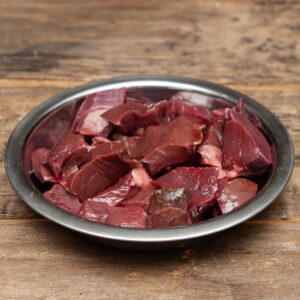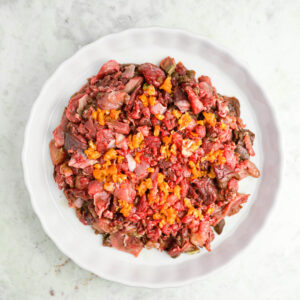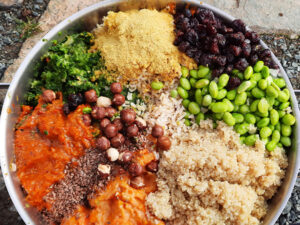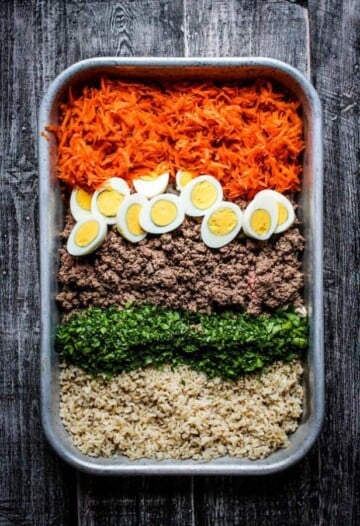Introduction
A recent study found that 95% of homemade dog food recipes—even those developed by veterinarians—are deficient in at least one major nutrient. That’s not good enough for us. So today, we’re showing you how to make, store, and feed one week’s worth of fully balanced homemade dog food so you can be confident that this food has everything your dog needs in it. This specific recipe is for a 40 lb dog, but at the very end, we’ll show you how easy it is to adjust these amounts so it’s perfect for your pup. You’re kind of digging your nails into me. Oh!
Supplies Needed
So, before we get started, we need to talk about the supplies that you’re going to need to make this meal. First up, I have a giant 14-cup stockpot. This, I found, is about enough to make a week’s worth of food for a 40 to 50 lb dog. You can also use a pressure cooker or a Crock-Pot if you want as well. Next up, we have a blender. This can be replaced by a food processor, a grinder, or just a knife and a cutting board, but we’re going to use it to cut up a lot of the meat so that the final product is a ground mixture. Then we have our storage bags. I have these gallon freezer bags for any extra food that we need to store kind of in bulk, and then we have these smaller bags, which will be the actual meal bags we fill up later. And look, I know—are these sustainable? No, they’re not. But let’s get homemade dog food down first, and then we can figure out how to make it more sustainable. Next up, we have a food scale. This is going to be very important—whoo—to make sure you get all of the proper amounts in there. A couple of utensils: tongs, spoon, tablespoon, cup, scissors, and then a bowl to actually measure all the stuff on. And then finally, some paper towels and a disinfectant spray to clean up later. If this is Force of Nature—not a sponsor or anything, just a big fan of their product.
Ingredients
And then when we look at ingredients, here’s what we’re going to need: beef heart as our main muscle meat, we also have some ground beef as our other main muscle meat, ground salmon, beef kidney as organ meat number one, beef liver as organ meat number two. Then our non-meat stuff: we have hemp hearts, some kelp, hemp seed oil, bone meal powder (because we’re not using any meaty bones today), and then turmeric. And most of this other stuff is just to kind of help balance it. Oh, and one other thing I forgot is frozen kale. The frozen kale and the hemp hearts are going to be our primary plant matter in this recipe.
Preparing the Meat
So, the way I want to set this up to make it really easy on ourselves is I have all of our ingredients here. We’re going to process our meat first and basically just blend it up in the blender. Then we’re going to weigh it, then we’re going to dump it into the pot. So once we dump everything in here, we know that’s the fully balanced recipe, and we’re ready to cook it. And now it’s just time to process our meat. So, grab our pair of scissors, grab our first item, which we should probably start with—beef heart—and we’re going to start blending. Now, I will say, you can skip this step if you have a dog that loves chunked meat. By all means, just maybe throw this in the oven instead of a pot and feed it to him chunked. But our dogs, we know, like the ground texture a lot more. So, the blender is working really hard. We’re going to switch to the food processor. Let’s try that one more time. So much better. Now, I’m not trying to absolutely pulverize this meat. I’m just trying to get it into a pretty ground consistency. We’re still going to have a few chunks, and that’s all right. So, I know, according to my recipe, I need just under 57 oz of beef heart. So, as I start dumping all this out, I’m going to make sure that I measure it too. So, that’s going to be all the beef heart for this recipe ground up. So, what I’m going to do is I’m going to toss all of this into the pot, which we’ll be cooking up later, and then I’m still going to blend up the rest of the beef heart and put it in some Ziploc bags. That way, the next time I make food, it’s super easy—it’s already ground up.
Processing the Organ Meats
Next up, we’re going to get our beef kidney blended up. If you have a picky dog, especially, blending up your organ meat is going to help a lot because we have two dogs: one of them is picky, and one of them really isn’t. But neither of them will eat whole organ meat. They like it ground up like this. Okay, so into the pot goes our kidney. All right, last organ meat—we got the beef liver going in. All right, that’s going to be all of our meats that need to be blended. The meats we have left are going to be ground beef and ground salmon. But if you need to grind your meat, just throw any other stuff in here like normal.
Adding Ground Beef and Salmon
So, next up, we got our ground beef. And I know that I’m going to need just over 3 and 1/2 lb. This entire bag is 2 and 1/2 lb, so I’m not going to measure this one. I’m just going to add it straight in. Then we have our ground salmon. Ooo, that smells like salmon. So, that’s all the meat, and that’s really all that needs to be cooked. So, all this other stuff, we’re going to add to the finished food once it’s done cooking. But right now, we’re going to throw this pot of meat on the stove. Let’s clear off the raw meat bits. We can ignore those. We’ll put it on, let’s say, medium-low heat for 20 or 30 minutes until it’s fully cooked through. But we don’t want to cook this at a really high temperature.

Preparing Bulk Storage
So, while that’s cooking, we’re going to get the rest of our stuff in bulk storage. And one thing you want to always remember is to write down what the food is and what date you’re putting it there. You have no idea how many times I’ve gone to grab something and I’m like, “Is this beef kidney or lamb pancreas?” So, now that we got all these in bags, I’m going to zip them all up, squeeze the air out, and then all of these will go in the freezer for bulk storage.
Cooking the Meat
All right, this ended up cooking for like 30 to 40 minutes—just a big pot of food. But I think we are all cooked through here. So, what I’ve done is I’ve killed the heat, and now we’re ready to add the rest of our ingredients.
Adding Non-Meat Ingredients
First thing we’re going to add is going to be our hemp seeds or hemp hearts here—just over 74 grams. Throw that right into the food. So, then it’s going to be 73 grams of hemp seed oil. So, now our dry stuff—we’re going to go with just over 56 grams of bone meal powder, 3.5 grams of kelp powder. One thing I have noticed is my current scale struggles with really small amounts, so that’s something to keep in mind. You may want to get a bit more of a sensitive scale, but I have this really tiny one that’s very accurate that we can do the kelp with. Okay, so that’s going to be all of our kelp going in there. As you can see, you really don’t need a lot of kelp to hit those iodine numbers. Second to last thing is our turmeric, and this is going to be 5.86 grams. All right, so all the dry goods are in there, and the very last thing we need to add is the kale—17 oz. That’s going to be a lot of kale. So, this is a pound. I’m just going to add this whole thing.

Mixing the Food
It’s time to give this a final mix here. Now, the thing about this—it’s not going to be perfectly mixed throughout because, you know, we’re human, and we can’t get it perfect. But this is a week’s worth of food. So, as long as you feed all of this food within the span of a week, your dog’s going to get all those nutrients that they need within that week. Not every single meal needs to be perfectly balanced, but about a week is as long as we like to go giving a balanced diet. Come on, that looks like freaking dog food, dude.
Bagging the Food
Okay, now we’re ready to bag everything up. We have our seven Ziploc bags ready to go. We have our food ready to be added. And the other cool thing about this is you don’t have to fill these bags perfectly even. Much like the balancing, as long as you feed all of this within a span of a week, your dog’s going to be getting all the calories that they need in that week. And be careful—the turmeric will stain your entire life. It’s insane. It’s like shark-infested waters when you drop something on the floor here. Now, we’re obviously going to get every single morsel of food out of here because we paid good money for all these ingredients. But you also want to make sure you feed all of the liquid in the pot. Luckily for us, the liquid has all kind of stuck to the food itself. But if there’s anything left over, dump it in with the rest of the food. So, now that these are all filled, again, we’re going to get the air squeezed out of them, get them sealed up, and then I’ll probably put three in the fridge for the next three days and the other four in the freezer because these only last about 3 days in the fridge. And remember that each one of these bags is one day’s worth of food. So, if you’re going to feed two meals, you want to split this in half. If you feed three meals, split it in thirds, etc.
Cleaning Up
And then we dealt with raw ingredients here, so we want to make sure we’re following all the safety practices. We’re going to wipe everything down with a disinfectant. We got all the dirty dishes in the sink. Those will go in the dishwasher, and they’ll go in the dishwasher on a sanitize-specific setting so we make sure to kill any of those bugs.
Final Tips
So, now you know how to actually make the food. If you want to get the correct amounts for your dog and their weight, head to our description, and there’s a spreadsheet down there that tells you, based on every 10 lb, this is how much of each ingredient you need. If you still have questions and you want to learn even more, we have a homemade diet guide that goes even more in-depth. That’s down in the description below as well. And it’s a sliding scale price system. Part of me was like wanting to maybe ask for your help with this, but I also want to show pet parents that, like, you can do this by yourself. Yeah, because not everybody has a partner that’s good at this






